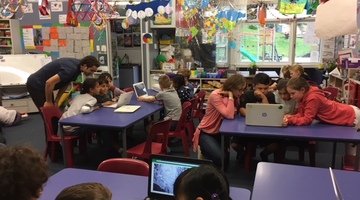Teacher Carol Brieseman explains why she used an online citizen science (OCS) project as part of a primary school unit on pest management at Hampton Hill School.
Although the OCS project – Identify New Zealand Animals – is now complete, she shares valuable insights into the benefits of using projects like this one as part of a wider unit of learning and taking action. The article, Invasive animals in cities gives more information on this project and the outcomes. These include:
-
contributing to a real science project
-
developing students’ science capabilities for citizenship
-
aligning with a universal design for learning – meeting the diverse and variable needs of all students.
The unit as a whole enabled students to develop the science capability Engage with science using the other capabilities to engage with science in real-life contexts.
In 2018, Carol was awarded the Prime Minister’s Science Teacher Prize.
Transcript
CAROL BRIESEMAN
We’ve been learning all about ecosystems and also have become involved with Pest Free Tawa. With that, we have tracking tunnels all around our school and then the kids were also able to identify little footprints – whether they were rats or mice or hedgehogs and things – and therefore from those tracking tunnels able to set traps around the place.
We wanted to make observations and collect data about the pests that were trapped at our school and also to get the students to learn that scientists make observations and then how they collect that data and how they act on that data.
The project I used was called Identify New Zealand Animals. This project was about helping biologists identify animals from photos, and it was a nice follow-up to our ecosystem and rat trapping – linking to real science investigations.
We were really fortunate with this project that one of the scientists involved was local – Victor – and he was more than happy to come out and visit our school and talk to the children all about the project, and that really got them hooked in. They sat up. You could see the determination and importance that they felt, a bit of mana in how they felt, yeah, we’re going to help this scientist with his project. And so that was a real sense of empowerment for them, and that just flowed on from there. It was really exciting.
Some of the main successes were the students having a real rich learning experience, really realising they were doing real science and the impact that they were having on that. It removed the classroom walls.
There was a lot of talk going on in the classroom, a lot of buzz and then even a little bit of competition going into how many observations each kid was making. Also when other work had been finished, they were allowed extra time to have a go. Why stop it? Yeah, it was great. There was a lot of enthusiasm that followed on into making sure that we were trapping our rats and mice around our local community, so that was a flow-on from this.
In writing time, I had them writing what it meant to be a citizen scientist, and that showed me that they were really understanding what it was.
Another thing I didn’t expect was one of my special needs boys to be so engaged with this. He was going along there and just experiencing success, just as well as a very able student. It was very cool.
The science capability engaging in science was huge here because we were dealing with real science, and the other one was interpreting data. We weren’t actually gathering it – it was already gathered for us – but interpreting data was a big one. I think also the nature of science, the investigating in science and also communicating in science was very important.
The students were learning to critique data and use integrity to make sure that they were doing the right thing. They really wanted to make sure that they were sure about their answers and they weren’t tainting the dataset.
I found that the online citizen science projects were a wonderful way to support a universal design of learning programme in the classroom. You have children at a very high ability, very able children, as well as kids with anxiety and children also with special needs who are all able to sit down there and identify a photo, and you have a key at the side there they were all able to do. It was simplistic and yet it was rich in its learning. That catered for children with a 5-year-old reading level right up to the very able children.
Acknowledgements
Carol Brieseman and her students at Hampton Hill School
Victoria University of Wellington
The Teaching & Learning Research Initiative
Pest Free Tawa
Animal footprint images from tracking tunnels, courtesy of Manaaki Whenua – Landcare Research
Identify New Zealand Animals (Zooniverse), courtesy of People, Cities and Nature
Dr Victor Anton
Still of Victor Anton with penguin, courtesy of Johannes Fischer
Still of rat trap with dead rats, courtesy of Annie Dick, CC BY-SA 4.0
Guide to Universal Design Learning (UDL) screen grabs courtesy of New Zealand Ministry of Education, Crown copyright.




